
Today I am so pleased to present our work on how chromatin remodelers affect mesoscale chromatin organization.
www.science.org/doi/10.1126/...
@axeldelamarre.bsky.social
I study Chromatin structure, organization and function. Postdoc in the Whitehouse lab, MSKCC, NYC. Former PhD in the Pasero lab, IGH, France.

Today I am so pleased to present our work on how chromatin remodelers affect mesoscale chromatin organization.
www.science.org/doi/10.1126/...

New preprint from the lab !! Loop extrusion may provide mechanical robustness to chromatin. Great work by Hossein Salari. @cnrs.fr @lbmcinlyon.bsky.social
www.biorxiv.org/content/10.1...
Thrilled that our work is now finally out in Nature Comms!
rdcu.be/eG3vP
We reveal cryo-EM structures of the MRN complex bound to DNA & TRF2 - showing how DNA breaks are sensed and regulated at telomeres.
Fantastic work by first authors @yilanfan.bsky.social @filizkuybu.bsky.social & Hengjun!

Congrats to my friends in the Boettiger lab for this really beautiful live imaging work. A big leap forward in understanding the dynamic side of genome organization. www.science.org/doi/10.1126/...
19.09.2025 06:20 — 👍 75 🔁 27 💬 1 📌 0Our new preprint is out@bioRxiv: www.biorxiv.org/content/10.1...
@masaashimazoe.bsky.social et al. reveal that linker histone H1 acts as a liquid-like glue to organize chromatin in living cells. 🎉 Fantastic collab with @rcollepardo.bsky.social @janhuemar.bsky.social and others—huge thanks! 🙌 1/

We’re back! Registration is NOW OPEN for the 6th Annual Meeting on Advances in Nuclear Topology & 3D Chromatin Architecture in Cancer. Don’t miss insights from leading experts in the field. Join us online on Nov 25, 2025—register for free: bit.ly/chromatin-2025 #chromatin2025
03.09.2025 14:00 — 👍 8 🔁 7 💬 2 📌 1
Checkout our latest research in @natcomms.nature.com
rdcu.be/eBqBI A high-resolution, nanopore-based artificial intelligence assay for DNA replication stress in human cancer cells. A collaboration with Mike Boemo’s team

Transcription and recombination are two universal DNA-dependent processes, but how they are coordinated remains largely unknown. Here we characterized transcription-recombination priority rules in yeast. 🧵 www.embopress.org/doi/full/10....
27.08.2025 12:00 — 👍 28 🔁 14 💬 1 📌 0
Oscillatory pattern of chain extension and nucleosome self-association with variation in protein-free DNA linker length in simulated nucleosome-decorated DNA chains. Regular structures bearing 15 nucleosomes constructed from the mean rigid-body parameters between successive base pairs; nucleosomal cores depicted as wedge-shaped objects and color-coded to highlight the two- and three-start organization of the structures. Nucleosomal DNA constrained to the 147-bp pathway found in the best-resolved core particle structure, pdb_id 1kx5

Distortions in the average structures of simulated nucleosome-decorated DNA chains introduced by changes in the positioning of a singe nucleosome. A. Local opening and unpacking of a compact array introduced by a single 2-bp increment in the spacing between nucleosomes. B. Kinking of an extended array by a single 5-bp increment in nucleosome spacing.

Effects of the nucleosomal DNA pathway on the average configurations of simulated 12-nucleosome arrays. Average structures bearing the undertwisted DNA found in the best-resolved core particle structure, pdb_id 1kx5, compared to the overtwisted DNA found in the RCC1-nucleosome complex, pdb_id 3mvd. The regulatory protein is not included in the simulations. Upper views looking perpendicular to the chromatin axis and lower views down the axis

Molecular 'snapshots' illustrating the potential effects of chain length and nucleosome positioning on large-scale chromatin folding. A. Smoothly deformed array of 78 nucleosomes with uniform 177-bp spacing. B. 77-nucleosome chromatin 'copolymer' containing three stretches of nucleosomes with different spacings: a compact array of 26 nucleosomes (deep brown) with 172-bp spacing at the 5́-end of the chain; an extended array of 26 nucleosomes (light brown) with 177-bp spacing in the middle; an opened array of 25 nucleosomes (yellow) with 207-bp spacing and a nucleosome-free gap at the 3́-end of the chain. Note the more pronounced junction between ‘helical’ stretches when the spacing changes by roughly a half turn of DNA (172 – 177 = –5 bp) than when altered by a multiple of the double-helical repeat (207 – 177 = 30 bp). The presence of a nucleosome-free gap, within the stretch of nucleosomes spaced at 207-bp intervals, enhances the flexibility of the modeled structure, allowing the chain to bend in various directions
Contributions of local structural and energetic features of DNA to large-scale genomic organization [perspective by Wilma Olson & Co) www.sciencedirect.com/science/arti...
23.08.2025 11:32 — 👍 11 🔁 5 💬 0 📌 0
Activity of most genes is controlled by multiple enhancers, but is there activation coordinated? We leveraged Nanopore to identify a specific set of elements that are simultaneously accessible on the same DNA molecules and are coordinated in their activation. www.biorxiv.org/content/10.1...
18.08.2025 12:23 — 👍 95 🔁 39 💬 2 📌 2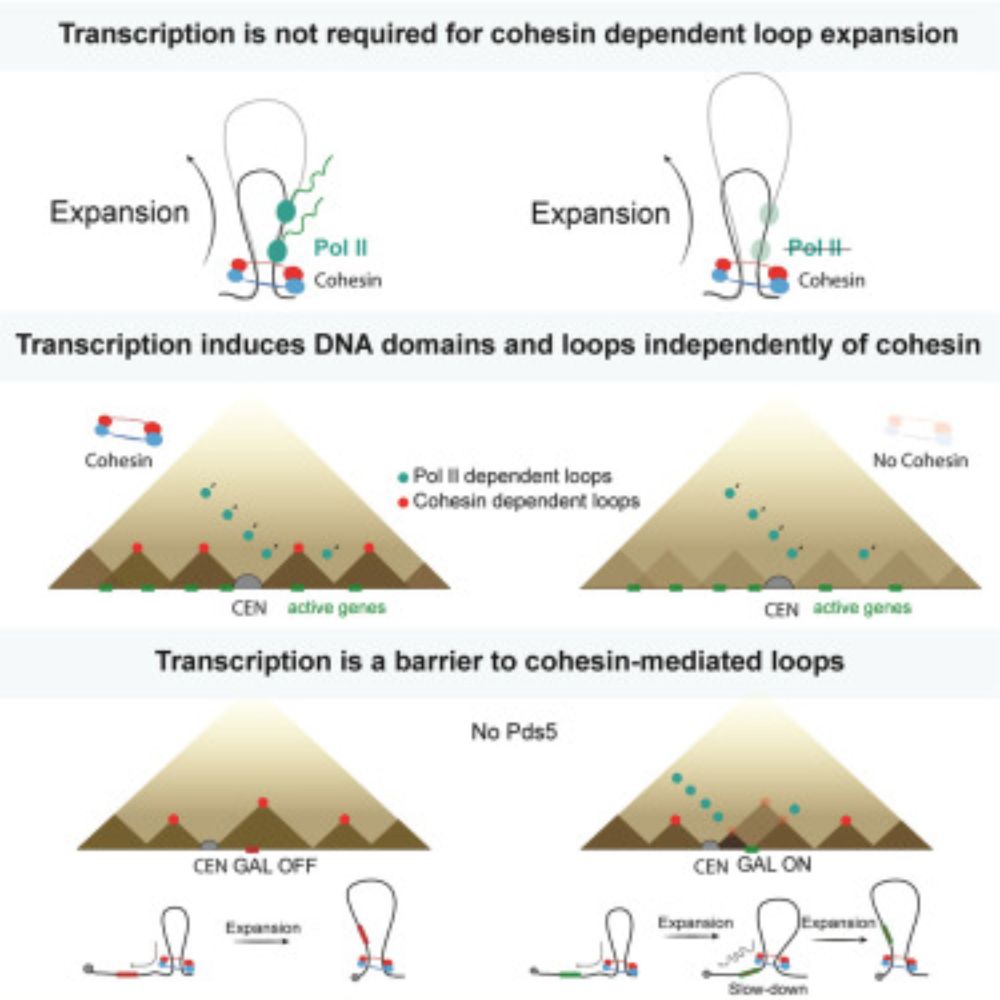
New work from @beckof.bsky.social and our lab's collaboration, with @alengronne.bsky.social! Multifaceted influence of transcription on yeast chromosome folding... loop extrusion of course but also active promoters making loops, bypassing centromeres boundaries
www.sciencedirect.com/science/arti...

New topology Pre-print from: @alengronne.bsky.social
Condensin and topoisomerases cooperate to relieve topological stress at stalled replication forks:
biorxiv.org/content/earl...
Very excited to share the first preprint of the lab! We show that the nuclear pore protein TPR forms biomolecular condensates which keep heterochromatin away from the nuclear pore complexes and maintains global chromatin organization. Check it out, share it, tell us what you think!!
21.07.2025 17:52 — 👍 29 🔁 8 💬 2 📌 2Our paper is now out in Molecular Cell!
Check the thread in this former post:
www.cell.com/molecular-ce...
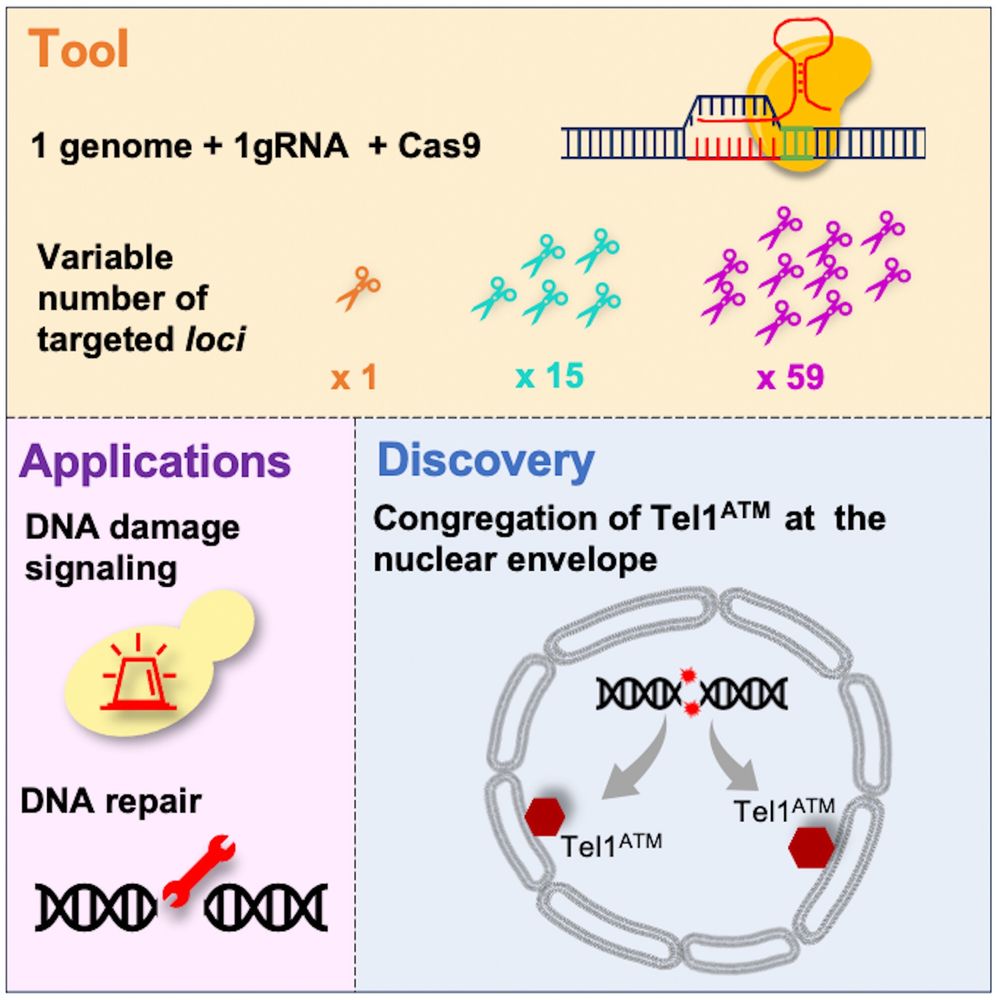
@morielab.bsky.social proudly presents a tool to induce, in S. cerevisiae, DNA double strand breaks in a site-specific AND in a dose-dependent manner, in a very simple way: just transform two plasmids!!! It allows you to assess many aspects of DNA damage signaling & repair!
doi.org/10.1111/febs...

PCP is a versatile method that captures multiple levels of chromatin organization at the single-molecule level all in one experiment!
Soon to be out - Check the updated BioRxiv!
11/11
www.biorxiv.org/content/10.1...

All reads are pair-end sequenced, measuring precise footprint of chromatin components. We identified abundant Overlapping Di-Nucleosomes (OLDN) at a subset of divergent promoters. This is supported by a single-molecule analysis showing that adjacent nucleosomes and OLDN are mutually exclusive.
10/11

Something surprising!
Not all fuzziness is due to transcription.
Rather, the genomic distance between two consecutive NFRs (Nuc Free Region) predict fuzziness. If the size is a multiple of the optimal Nucleosome Repeat Length (NRL) => Positioned Array. If not => Delocalized Array.
9/11

On very highly expressed genes, long arrays disappear, and nucleosomes typically exist in pairs. Shutting down transcription resolves the fuzziness on some genes, re-establishing nucleosomes arrays.
8/11

On short range interaction, PCP will tag nucs from the same fiber with the same UMI. This reveals that “fuzzy” nucs in classical MNase-seq profiles correspond to well-spaced nucleosome arrays slightly offset from cell-to-cell.
7/11

Interaction matrix sometimes show signal between three consecutive cohesin peaks, suggesting multiway interaction. But Micro-C can only detect pairwise interactions. With PCP we show that cohesin tends to form hubs of multiway interactions.
6/11

We can bin the results in classical interaction matrices. On S. cerevisiae, PCP perform as well as Micro-C (i.e. detecting Cohesin loops in G2). At high-resolution PCP performs better and provide a more detailed picture of nucleosome interactions.
5/11

We used PCP to map chromatin structure:
Chromatin is X-linked and digested to mononucs, a mixture of Seeds and Receptors is ligated to DNA ends. Each seed will produce unique tagRNAs and tag nucs in proximity.
After sequencing, reads are grouped based on the UMI, informing on spatial proximity.

The new method is based on a simple reaction:
• A Seed is transcribed to produce a tagRNA carrying: a unique identifier (UMI) and an annealing sequence.
• The tagRNAs diffuse and anneal to Receptors sharing the annealing sequence
• The annealed tagRNA is copied by RT to “tag” the Receptor
3/11
Why a new method for 3D maps?
Gold standard high throughput 3C based methods are great but have limits:
• multi-way interactions are not assessed
• bias toward short-range interactions
• output is a population average obscuring population heterogeneity
2/11
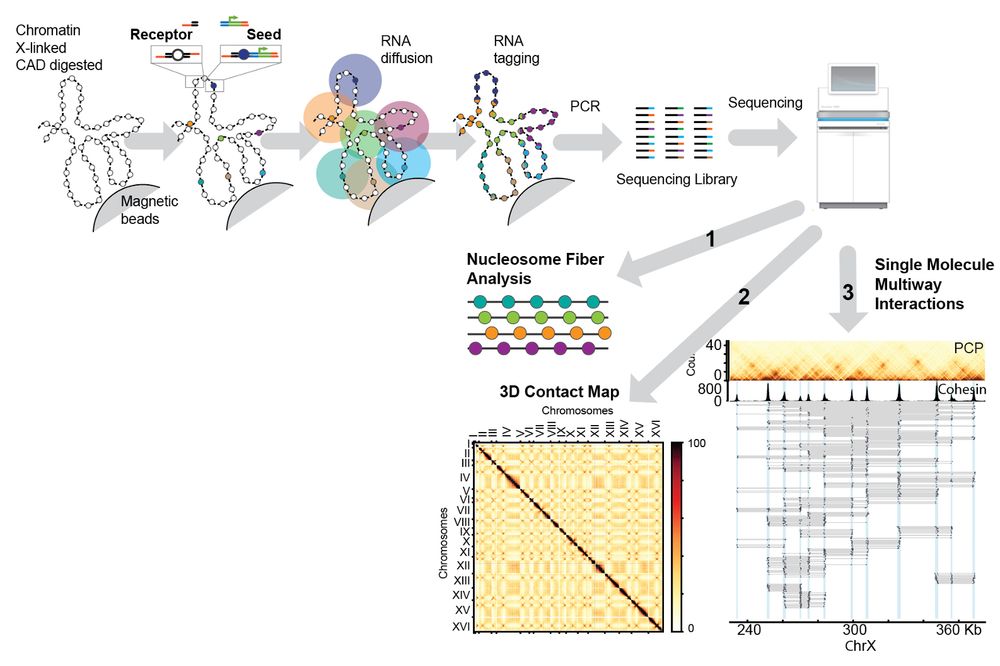
Hi everyone!
The latest method from the Whitehouse lab: PCP
PCP uses a novel proximity barcoding strategy to simultaneously map 3D genome organization at various resolutions at the single molecule level:
Out soon, check the updated BioRxiv – little thread:
1/11
www.biorxiv.org/content/10.1...
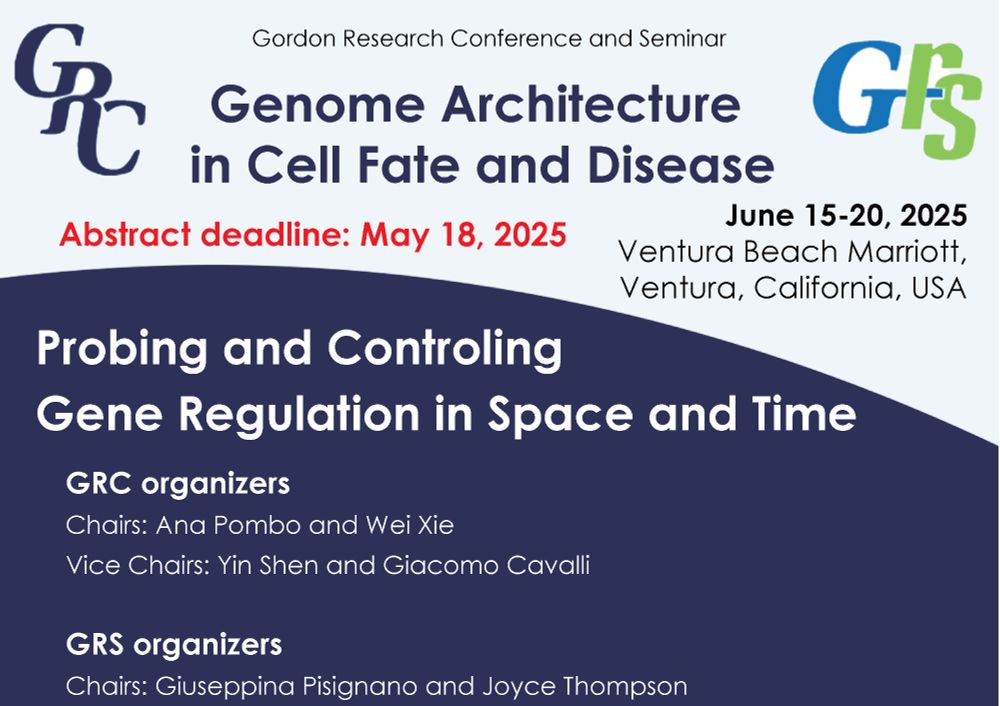
Join us for the 2025 GRC Genome Architecture www.grc.org/genome-archi... @spp2202.bsky.social @jobdekker.bsky.social @metorrespadilla.bsky.social @jopkind.bsky.social @dimplenotani.bsky.social @stanleyqilab.bsky.social @andybelmont.bsky.social @fondufemittendorf.bsky.social @boyanbonev.bsky.social
09.03.2025 23:08 — 👍 31 🔁 12 💬 0 📌 0Excited to share our preprint on the molecular architecture of heterochromatin in human cells 🧬🔬w/ @jpkreysing.bsky.social, @johannesbetz.bsky.social,
@marinalusic.bsky.social, Turoňová lab, @hummerlab.bsky.social @becklab.bsky.social @mpibp.bsky.social
🔗 Preprint here tinyurl.com/3a74uanv
Excellent thread on the paper from Meneu, Chapard et al. The latest from the Koszul and friends lab!
www.science.org/doi/10.1126/...
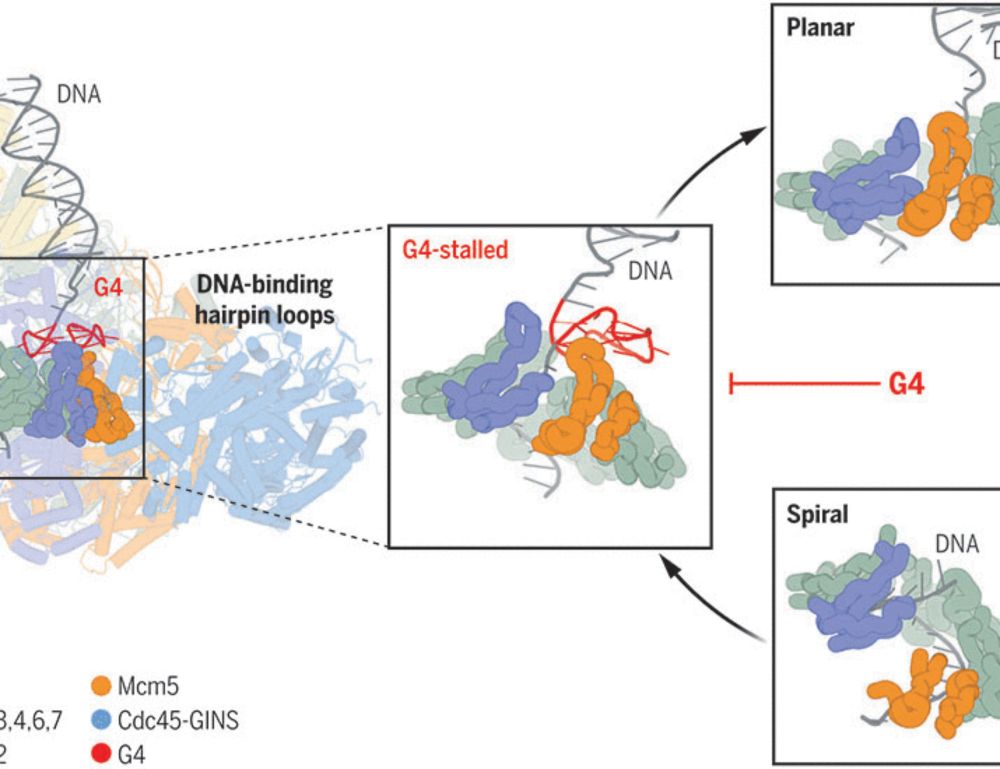
Thrilled to share first part of my post-doc work, published today in @science.org www.science.org/doi/10.1126/...
We use reconstituted replication system and cryo-EM to unravel an unexpected mechanism of DNA translocation employed by eukaryotic replicative helicase.